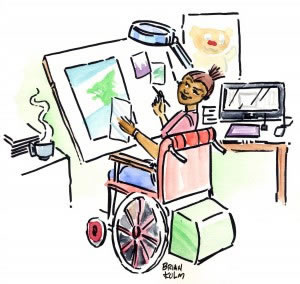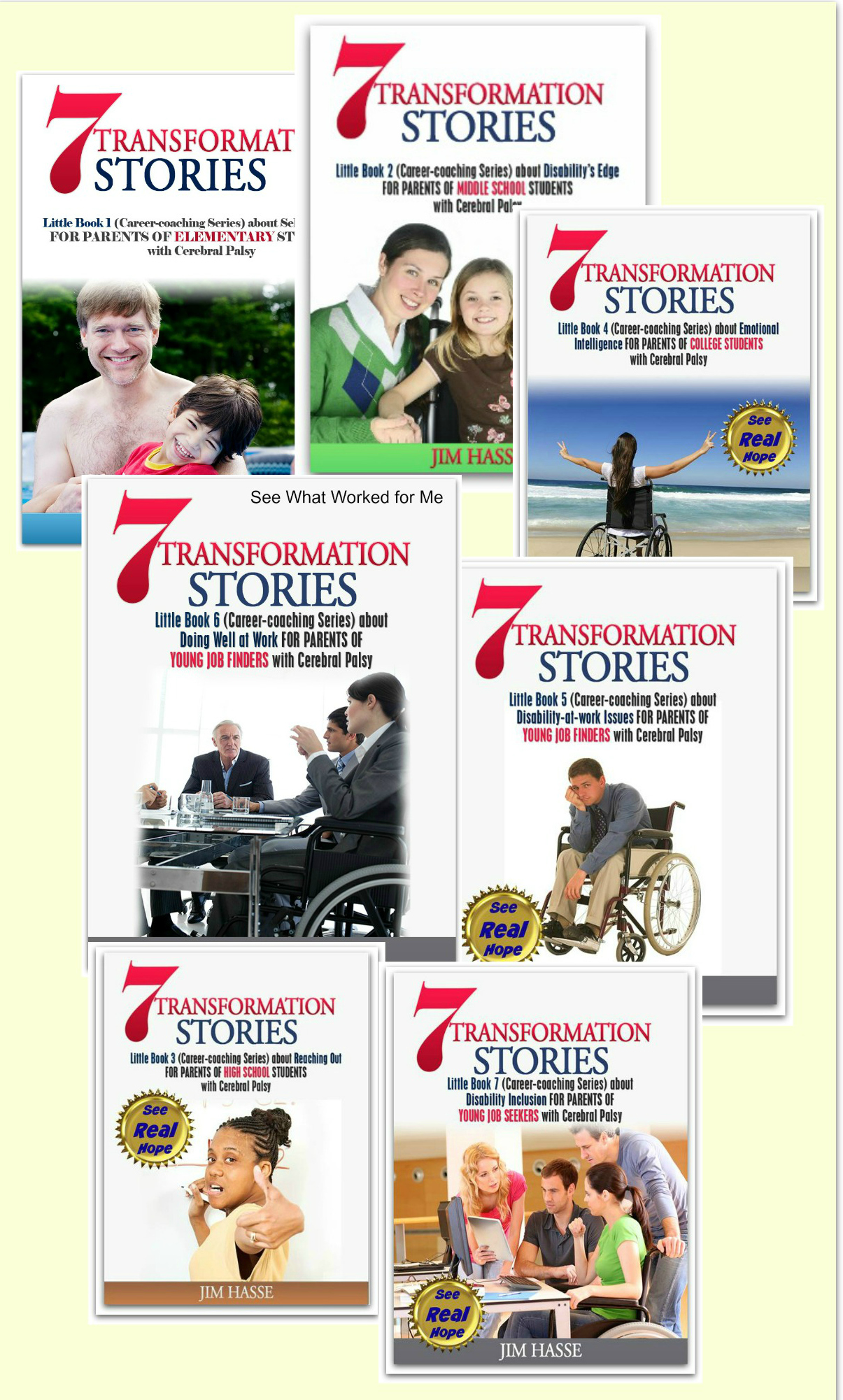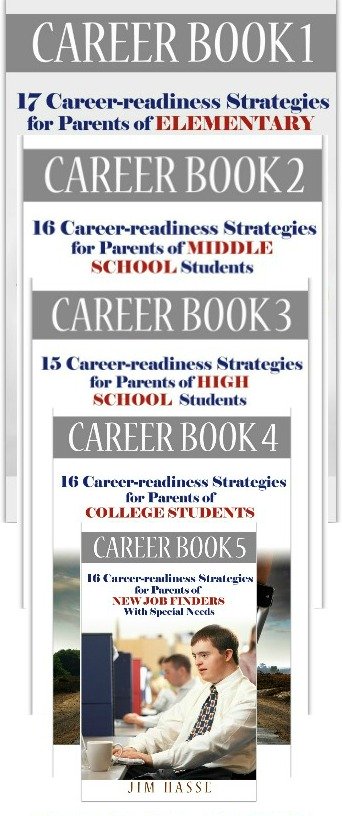Effective Goal Setting: Cerebral Palsy
Career Builder for High School Students
By Jim Hasse, ABC, GCDF, Disability Employment Expert
_________________________________________________________
Effective goal setting is an integral part of learning how to develop a meaningful career. It’s a skill your son or daughter with cerebral palsy (CP) needs to start learning in high school.
Goals need to have substance. They must be connected to your youngster’s values.
Imagine for a moment that your youngster has the desire to be a computer network administrator for a medium-sized company. How can he or she embark on this journey (which will likely entail years of training and hands-on experience) without making plans? Without establishing goals, how would your youngster know when he or she had achieved that dream?
Your high school student needs to practice these two steps for effective goal setting.
'First, effective goal setting asks, “Where am I going?”
In the business world, job seekers succeed because they know where they want to go. It is essential to set both short-term and long-term goals in a sequence that shows where they’re going. These goals become more potent and more easily attainable when they are aligned with personal values and drive by a personal vision.
So, effective goal setting for your high school student starts with exploring and understanding personal values, the guiding principles for your youngster’s personal and eventual working life.
When I was 14, I knew I wanted to write as a vocation because, for me, writing was a way to increase understanding (my personal value) within a diverse group of people. That understanding would help people work together more effectively (my vision).
Your youngster’s values and vision are closely tied to his or her personal interests, one of the drivers of career development. Observation and casual conversation over the years can give you a good idea of what your youngster values most when it comes to a vocation: challenge, security, relaxation, renewal, adventure, an exotic environment etc.
Examples of values include excellence, honesty, innovation, spirituality, respect, and authenticity. Help your youngster think of values as guiding principles: what he or she wants and needs in a personal and work life.
Help your youngster make a list of values. Then, together, look for patterns and ways to group individual values together.
After reviewing my list of values as a 51 year old, for instance, with the help of a career coach, I grouped them into three distinct categories – learning, adventure, and communication. My communication category included creativity, authenticity, and connecting.
The next step is to create a clarifying statement, blending the values that your high school student has grouped into a category. Let’s continue to use my communication example. I developed the following clarifying statement:
"I value effective communication. It’s an essential part of who I am, both personally and professionally. Authenticity is an important part of communication for me. I strive to be authentic in the way I connect with others. I value life-long learning, and I continually work to sharpen my writing and strategic communication skills."
Your youngster’s clarifying value statements can play a key role in the development of his or her personal brand.
For instance, I brand myself as a “disability employment expert who helps individuals put disability to work as a competitive edge in today’s job market.” That’s my 15-second elevator pitch, a reply I can use when I’m asked, “What do you do?”
My statement often leads to question in reply: “How do you do that?”
My standard response: “I walk the people I coach through a series of career builders so they can gain the confidence they need to deal effectively with disability employment issues.”
But, in today’s world, even my 1980s elevator pitch is too long. So, now I use three words to describe what I do: “Showing Disability Works.”
 Illustration courtesy of ilrcsf.org.
Illustration courtesy of ilrcsf.org.Second, effective goal setting asks, “How do I get there?”
Goal setting is the methodology by which individuals can systematically support their success. Accomplishing goals helps to create and sustain that success.
As your youngster begins to develop goals, guide him or her through the following questions:
- Is there something that needs to be completed?
- Do you have a concern that is unresolved?
- Do you have an unfulfilled dream?
- What things should have had a higher priority this last year?
When establishing a goal, our popular culture likes to cite the SMART principle:
- Specific: Be very specific in writing a goal.
- Measurable: Develop criteria to measure progress and success.
- Attainable: Be sure the goal is realistic and attainable.
- Relevant: Consider personal values. Is it relevant?
- Time Bound: Establish timeframes.
But, Dr. Samantha Collins, CEO of Aspire Companies and founder of The Aspire Foundation (a mentorship program for women across 24 countries), is not a big fan of SMART goals, especially for high school students.
She recommends, instead, “developing more of a vision, going to your highest level.”
She adds, “You don’t have to be realistic at this stage. Your vision should invoke excitement as well as slight terror -- terror because you’re clueless about how you’re going to pull it all off. All the planning can come later.”
In my case, I always had my values in my heart and my vision in my head. But, I could never make SMART work as an effective goal setting process because it didn’t seem to be helpful for me.
Instead, embracing happenstance, being open to change and knowing my end point (being able to live independently) seemed to work well for me. In short, I’ll admit that I “winged it” until I reached middle age.
I have a hunch that whichever effective goal setting track your youngster finds helpful will depend on his or her temperament.
Return from Effective Goal Setting to Part-time Jobs
Go to Cerebral Palsy Career
Builders
This is Creative Commons content. You can freely and legally use, share and repurpose it for non-commercial purposes only, provided you attach this sentence and the following attribution to it (including the two links):
Originally written and illustrated by Jim Hasse, ABC, GCDF, owner of Hasse Communication Counseling, LLC, who, as a person with cerebral palsy, served for 10 years as a vice president in a Fortune 500 company during his 29-year career in corporate communication. He’s an Accredited Business Communicator, certified as a Global Career Development Facilitator and author of 14 Amazon books about disability awareness and disability employment issues.





